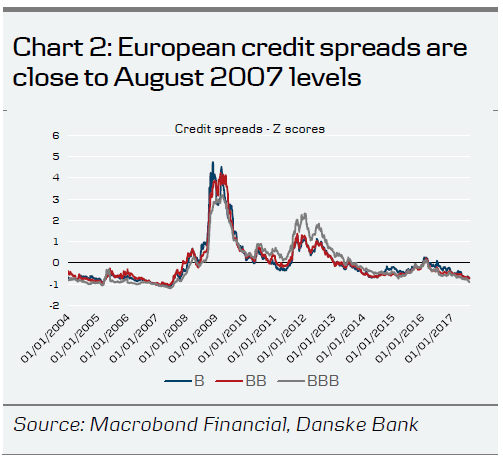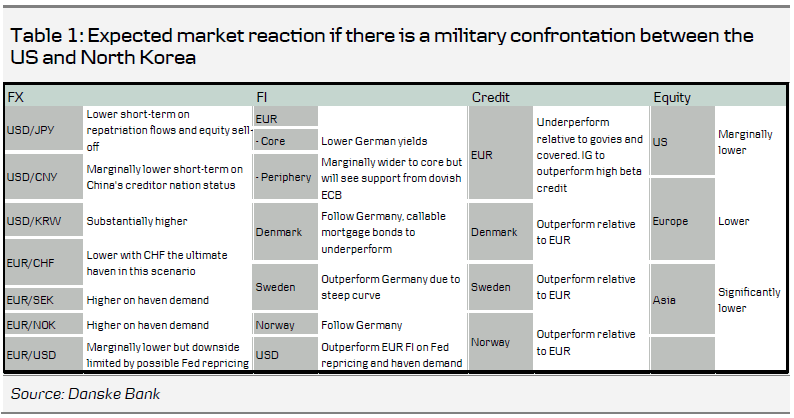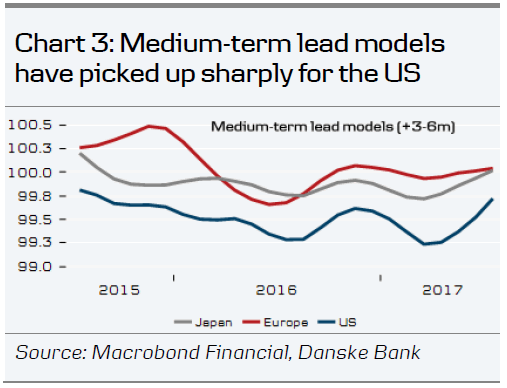Key points
- A military confrontation between US and North Korea is a lowprobability but high-impact event for markets.
- Current risk aversion is likely to be temporary although it will be bumpy and headline-driven.
- If there is a military confrontation, we would expect an acceleration of this week’s price action.
- Our quantitative business cycle model signals that the US is gaining speed.
- A pick-up in US growth suggests that US yields and equities should head higher when North Korean tensions fade.
A low-probability but high-impact event for markets
This week, tensions have escalated between North Korea and the US. The recent chain of events started after the United Nations Security Council last weekend hit Pyongyang with new sanctions as punishment for North Korea’s aggressive missile testing programme. This triggered aggressive comments from North Korea followed up by a statement by US President Donald Trump on Tuesday, in which he said that the country’s threat would be ‘met with fire and fury like the world has never seen’. The North Korean regime responded by threatening to attack the US’s Pacific territory of Guam by launching four intermediaterange missiles which would land about 20 miles offshore and could be launched as soon as next week. On Thursday, President Trump said that his statement on Tuesday ‘maybe wasn’t tough enough’.
The driver behind the escalation is North Korea advancing fast in developing an Intercontinental Ballistic Missile (ICBM) that could reach the US with a nuclear warhead. North Korea conducted its first ICBM test on 4 July and followed up with a second ICBM test on 28 July which led to the recent UN sanctions. How close North Korea is to posing a nuclear threat to the US mainland is difficult to say, but the Pentagon’s Defence Intelligence Agency announced on Tuesday that they believe North Korea will be able to field a reliable, nuclear-capable ICBM as early as next year. North Korean tensions have gradually risen since Kim Jong Un came to power in 2011 and the current situation is probably the most tense it has been for many years. (See Chart 1). Still, the most likely scenario is that the current escalation of events does not lead to a military confrontation as both parties will have too much to lose from such an outcome. However, it is also difficult to foresee a sudden improvement in US-North Korean relations and recent events may increase long-term frictions in US-China relations.

Markets have reacted as expected this week with yields of US and German government bonds declining, equities selling off and safe-haven currencies like the Swiss Franc (CHF) and the Japanese yen (JPY) strengthening. Although Japan is close to the epicentre of the crisis, the JPY typically strengthens during North Korean tensions as Japan is a creditor nation and local investors typically ‘bring money home’ when they face a crisis. Despite a slight pick-up in market volatility, risk premiums are very low across asset classes. For example, VIX volatility and Europe

Military confrontation between the US and North Korea is a low-probability but highimpact event for markets. That naturally makes it difficult for markets to price it. In recent years, geopolitical tensions have had a brief, albeit sharp, impact on markets as central banks have come to the rescue. In our base case, in which the North Korean situation does not escalate into a military confrontation, we would expect the current risk aversion to be temporary although it is likely to be bumpy and very much headlinedriven. In the risk scenario, where the current tensions escalate sharply, we would expect an acceleration of this week’s price action, i.e. a sharp rise in risk premiums across asset classes, substantial falls in US and German government bonds yields, significant JPY and CHF strength and a massive sell-off in equities, particularly in Europe which is more linked into the global cycle. (See Table 1).

Looking beyond North Korea and assuming that the situation does not escalate, the world economy is looking strong. Our quantitative business cycle model, MacroScope, signals that the global recovery will remain intact in H2 and that the US economy is gaining speed (see Chart 3). This is positive for equities, especially for the US. The positive cyclical outlook for the US also supports our view that US yields will head higher in coming months. In terms of EUR/USD, we expect the recent sharp move higher to fade heading into the Jackson Hole conference 24-26 August and the ECB meeting on 7 September. We believe the ECB president Mario Draghi will be cautious in not sounding too confident given the recent sharp rise in the effective EUR which has risen to its highest level since Q4-2014. We forecast EUR/USD at 1.17 in 1M and 3M before the next leg higher towards 1.22 in 12M.

Global market views
Equities
Our short-term trading opportunity stance (0-1 month): Buy on dips
Our strategy stance (3-6M): Neutral on equities vs cash
We keep our short-term buy-on dips stance, as we think the fundamental factors (the global cycle and earnings) are stills strong. So far, history shows that geopolitical shocks are not able to offset the equity markets as long as the cycle is strong. On a longer-term basis, we remain neutral on equities, as we have been since April this year.
Bond market
German/Scandi yields – set to stay in recent range for now, higher o n 12M horizon
Inflation to stay subdued despite decent growth. Stronger euro keeps euro inflatio n outlook down. ECB to normalise gradually only, due to lack of wage pressure and stronger euro.
If the situation in North Korea escalates further it can add renewed downward pressure on global yields.
EU curve – 2Y10Y set to steepen when long yields rise again
The ECB keeps a tight leash on the short end of the curve. With 10Y yields stable, the curve should change little on a 3-6M horizon. Risk is skewed towards a steeper curve earlier than we forecast.
US-euro spread set to widen marginally
The Fed’s QT programme (balance sheet reduction) is to happen at a very gradual pace and impact on the Treasury market should be benign. Yet market pricing for Fed hikes is very dovish and yields should edge higher on 12M horizon.
Peripheral spreads – tightening but still so me facto rs to watch
Economic recovery, ECB stimuli, better fundamentals, particularly in Portugal and Spain and an improved political picture are expected to lead to further tightening despite the recent strong moves. Italy is the big risk factor.
FX
EUR/USD – up momentum wearing off but set fo r 1.20 and beyond in 2018
EUR/USD has turned for good as ECB has reluctantly allowed ‘reverse gravity’ to kick in but upward momentum set to wear off near term. EUR/USD at 1.22 in 12M.
EUR/GBP – downside risks po stpo ned as BOE stays put
Relative growth and monetary policy support a higher EUR/GBP near-term. Cross above 0.90 in 3M before a downward move further out on Brexit clarification, valuation.
USD/JPY – gradually higher longer term A BoJ set to sidelined in central-bank exit talk should cap
JPY upside for an extended perio d. Fed and ECB eagerness to tighten is set to support EUR/JPY and USD/JPY near term.
EUR/SEK – range-bound near term, then gradually lower
Gradually lower medium-term on fundamentals and valuation longer term but near-term SEK potential limited by the Riksbank.
EUR/NOK – range-bound near term, then gradually lower Headwinds near term due to low oil prices but longer term
NOK should rebound on valuation, growth and real-rate differentials normalising.
Commodities
Oil price – range-bound, do wnside risk
Rebound recently on better China data and robust global growth. Still range bound and now in middle of range.
Metal prices – range-bound, do wnside risk
Underlying support from consolidation in mining industry, better China data lately. China to slow again after National Congress adding downside risks in the medium term.
Go ld price – range-bound
Tug of war between geopolitical uncertainty and stronger USD.
Agriculturals – stabilisation
Dry weather created supply concerns but prices have come down again lately.















